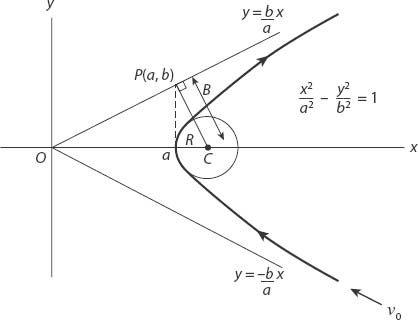X and the City: Modeling Aspects of Urban Life (87 page)
Read X and the City: Modeling Aspects of Urban Life Online
Authors: John A. Adam


Figure A12.1. The asteroid’s hyperbolic orbit drawn for “grazing incidence” with the Earth. The impact parameter
B
is the perpendicular distance of the asymptote from the Earth”s center of attraction at
C
. The radius of the Earth is
R
and the speed of the asteroid “at infinity” is
v
0
.

where
m
a
is the mass of the asteroid,
M
e
is the mass of the Earth, and
G
is the gravitational constant. At the perigee distance we suppose the asteroid speed relative to the Earth to be
v
p
, and we apply the principle of the conservation of energy to the asteroid, namely, that the

that is,

or, simplifying,

Another fundamental principle is the conservation of angular momentum,

that is,

Elimination of
v
p
from these two equations results in

In this equation
v
e
= (2
GM
e
/R
)
1/2
is the escape velocity from the surface of the Earth. To see this we equate the “escape” kinetic energy with the potential energy of a particle of unit mass at infinity. Thus

from which the result follows. Incidentally,
v
e
≈ 11.2 km/s. Equation (A12.5) gives that the ratio of capture-to-geometric cross sections has a lower bound of one, as would be expected. It differs significantly from this value only when
v
0
<
v
e
; thus for
v
0
= 0.7
v
e
,
B
2
/
R
2
≈ 3.
As pointed out by Tatum [
47
], there
is
a class of asteroids that approach our planet quite closely, and with small relative speeds, so the CCS/GCS ratio for these may be quite large. One such object is 1991 VG, which at that time was, at eight meters, the smallest astronomical object ever discovered (in orbit). The semi-major axis of its orbit is 1.04 astronomical units (≈ 1.50 × 10
8
km; the mean Earth-sun distance is approximately 1 A.U.). The eccentricity of its orbit is 0.067 (Earth’s is 0.0167), which brings it inside the Earth’s orbit for part of the time. With this in mind, let the Earth move again (Oh, the power of mathematics!), in a circular orbit for simplicity, and imagine such an asteroid in a nearby circular orbit. Obviously we expect that these orbits will not be concentric in practice, but they may be close enough for a significant portion of the orbit to make this simplification useful. If the distance apart of the two orbits is less than the radius of the CCS, then the object can be captured. The closer the orbit is to that of the Earth, the smaller the relative speed and the larger the CCS becomes.
Suppose that the speed of the Earth in its orbit is
V
with orbit radius
a
, and the corresponding speed and orbit radius for the asteroid are
V
+
δV
and
a
+
δa
, respectively. Now Kepler’s third law of planetary motion states that the square of the orbital period
P
of a planet is directly proportional to the cube of the semi-major axis of its orbit (here
a
), or in terms of a constant of proportionality
K
,
P
2
=
Ka
3
. For a circular orbit,
P
= 2
πa
/
V
e
so that on eliminating
P
, Kepler’s law reduces to

Using differentials it follows that the relative difference in speed between the two objects is

